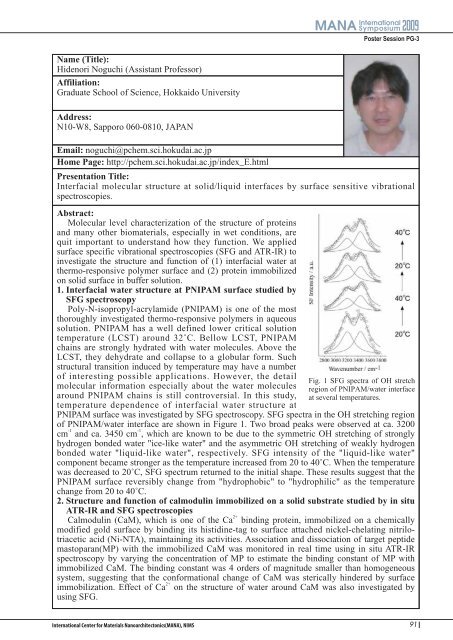Abstract Download (8.38MB)
Abstract Download (8.38MB)
Abstract Download (8.38MB)
Create successful ePaper yourself
Turn your PDF publications into a flip-book with our unique Google optimized e-Paper software.
Name (Title):<br />
Hidenori Noguchi (Assistant Professor)<br />
Affiliation:<br />
Graduate School of Science, Hokkaido University<br />
Address:<br />
N10-W8, Sapporo 060-0810, JAPAN<br />
Email: noguchi@pchem.sci.hokudai.ac.jp<br />
Home Page: http://pchem.sci.hokudai.ac.jp/index_E.html<br />
Presentation Title:<br />
Interfacial molecular structure at solid/liquid interfaces by surface sensitive vibrational<br />
spectroscopies.<br />
<strong>Abstract</strong>:<br />
Molecular level characterization of the structure of proteins<br />
and many other biomaterials, especially in wet conditions, are<br />
quit important to understand how they function. We applied<br />
surface specific vibrational spectroscopies (SFG and ATR-IR) to<br />
investigate the structure and function of (1) interfacial water at<br />
thermo-responsive polymer surface and (2) protein immobilized<br />
on solid surface in buffer solution.<br />
1. Interfacial water structure at PNIPAM surface studied by<br />
SFG spectroscopy<br />
Poly-N-isopropyl-acrylamide (PNIPAM) is one of the most<br />
thoroughly investigated thermo-responsive polymers in aqueous<br />
solution. PNIPAM has a well defined lower critical solution<br />
temperature (LCST) around 32˚C. Bellow LCST, PNIPAM<br />
chains are strongly hydrated with water molecules. Above the<br />
LCST, they dehydrate and collapse to a globular form. Such<br />
structural transition induced by temperature may have a number<br />
of interesting possible applications. However, the detail<br />
molecular information especially about the water molecules<br />
around PNIPAM chains is still controversial. In this study,<br />
temperature dependence of interfacial water structure at<br />
Poster Session PG-3<br />
Fig. 1 SFG spectra of OH stretch<br />
region of PNIPAM/water interface<br />
at several temperatures.<br />
PNIPAM surface was investigated by SFG spectroscopy. SFG spectra in the OH stretching region<br />
of PNIPAM/water interface are shown in Figure 1. Two broad peaks were observed at ca. 3200<br />
cm -1 and ca. 3450 cm -1 , which are known to be due to the symmetric OH stretching of strongly<br />
hydrogen bonded water "ice-like water" and the asymmetric OH stretching of weakly hydrogen<br />
bonded water "liquid-like water", respectively. SFG intensity of the "liquid-like water"<br />
component became stronger as the temperature increased from 20 to 40˚C. When the temperature<br />
was decreased to 20˚C, SFG spectrum returned to the initial shape. These results suggest that the<br />
PNIPAM surface reversibly change from "hydrophobic" to "hydrophilic" as the temperature<br />
change from 20 to 40˚C.<br />
2. Structure and function of calmodulin immobilized on a solid substrate studied by in situ<br />
ATR-IR and SFG spectroscopies<br />
Calmodulin (CaM), which is one of the Ca 2+ binding protein, immobilized on a chemically<br />
modified gold surface by binding its histidine-tag to surface attached nickel-chelating nitrilotriacetic<br />
acid (Ni-NTA), maintaining its activities. Association and dissociation of target peptide<br />
mastoparan(MP) with the immobilized CaM was monitored in real time using in situ ATR-IR<br />
spectroscopy by varying the concentration of MP to estimate the binding constant of MP with<br />
immobilized CaM. The binding constant was 4 orders of magnitude smaller than homogeneous<br />
system, suggesting that the conformational change of CaM was sterically hindered by surface<br />
immobilization. Effect of Ca 2+ on the structure of water around CaM was also investigated by<br />
using SFG.<br />
91















